Gali Ltd: Fair Value Measurement and Asset Impairment Calculation
VerifiedAdded on 2023/04/03
|6
|1709
|382
Homework Assignment
AI Summary
This document provides a comprehensive analysis of fair value measurement and asset impairment, focusing on the principles outlined in AASB 13. It defines fair value, emphasizing its market-oriented nature and the importance of considering market participant perspectives. The document explores the three valuation techniques – market, cost, and income approaches – and the three-level hierarchy for data. It then applies these concepts to a case study of Gali Limited, calculating impairment losses for various assets (Goodwill, Equipment, Franchise, and Furniture) based on their carrying amounts and recoverable amounts (value in use). The solution includes detailed calculations, journal entries, and references to relevant accounting standards. The document provides insights into the practical application of these standards in financial reporting, including how to determine impairment losses and record them in the financial statements.
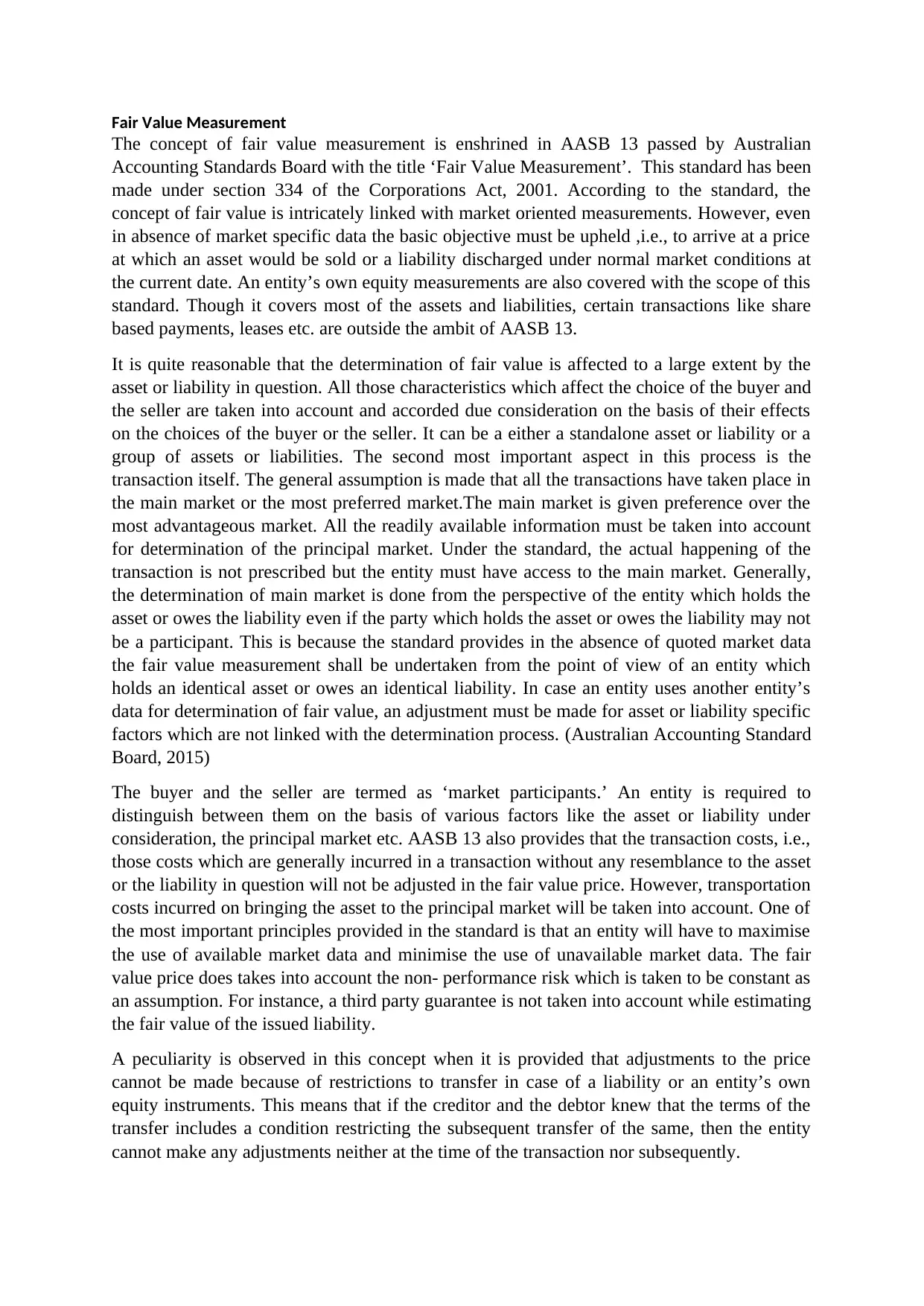
Fair Value Measurement
The concept of fair value measurement is enshrined in AASB 13 passed by Australian
Accounting Standards Board with the title ‘Fair Value Measurement’. This standard has been
made under section 334 of the Corporations Act, 2001. According to the standard, the
concept of fair value is intricately linked with market oriented measurements. However, even
in absence of market specific data the basic objective must be upheld ,i.e., to arrive at a price
at which an asset would be sold or a liability discharged under normal market conditions at
the current date. An entity’s own equity measurements are also covered with the scope of this
standard. Though it covers most of the assets and liabilities, certain transactions like share
based payments, leases etc. are outside the ambit of AASB 13.
It is quite reasonable that the determination of fair value is affected to a large extent by the
asset or liability in question. All those characteristics which affect the choice of the buyer and
the seller are taken into account and accorded due consideration on the basis of their effects
on the choices of the buyer or the seller. It can be a either a standalone asset or liability or a
group of assets or liabilities. The second most important aspect in this process is the
transaction itself. The general assumption is made that all the transactions have taken place in
the main market or the most preferred market.The main market is given preference over the
most advantageous market. All the readily available information must be taken into account
for determination of the principal market. Under the standard, the actual happening of the
transaction is not prescribed but the entity must have access to the main market. Generally,
the determination of main market is done from the perspective of the entity which holds the
asset or owes the liability even if the party which holds the asset or owes the liability may not
be a participant. This is because the standard provides in the absence of quoted market data
the fair value measurement shall be undertaken from the point of view of an entity which
holds an identical asset or owes an identical liability. In case an entity uses another entity’s
data for determination of fair value, an adjustment must be made for asset or liability specific
factors which are not linked with the determination process. (Australian Accounting Standard
Board, 2015)
The buyer and the seller are termed as ‘market participants.’ An entity is required to
distinguish between them on the basis of various factors like the asset or liability under
consideration, the principal market etc. AASB 13 also provides that the transaction costs, i.e.,
those costs which are generally incurred in a transaction without any resemblance to the asset
or the liability in question will not be adjusted in the fair value price. However, transportation
costs incurred on bringing the asset to the principal market will be taken into account. One of
the most important principles provided in the standard is that an entity will have to maximise
the use of available market data and minimise the use of unavailable market data. The fair
value price does takes into account the non- performance risk which is taken to be constant as
an assumption. For instance, a third party guarantee is not taken into account while estimating
the fair value of the issued liability.
A peculiarity is observed in this concept when it is provided that adjustments to the price
cannot be made because of restrictions to transfer in case of a liability or an entity’s own
equity instruments. This means that if the creditor and the debtor knew that the terms of the
transfer includes a condition restricting the subsequent transfer of the same, then the entity
cannot make any adjustments neither at the time of the transaction nor subsequently.
The concept of fair value measurement is enshrined in AASB 13 passed by Australian
Accounting Standards Board with the title ‘Fair Value Measurement’. This standard has been
made under section 334 of the Corporations Act, 2001. According to the standard, the
concept of fair value is intricately linked with market oriented measurements. However, even
in absence of market specific data the basic objective must be upheld ,i.e., to arrive at a price
at which an asset would be sold or a liability discharged under normal market conditions at
the current date. An entity’s own equity measurements are also covered with the scope of this
standard. Though it covers most of the assets and liabilities, certain transactions like share
based payments, leases etc. are outside the ambit of AASB 13.
It is quite reasonable that the determination of fair value is affected to a large extent by the
asset or liability in question. All those characteristics which affect the choice of the buyer and
the seller are taken into account and accorded due consideration on the basis of their effects
on the choices of the buyer or the seller. It can be a either a standalone asset or liability or a
group of assets or liabilities. The second most important aspect in this process is the
transaction itself. The general assumption is made that all the transactions have taken place in
the main market or the most preferred market.The main market is given preference over the
most advantageous market. All the readily available information must be taken into account
for determination of the principal market. Under the standard, the actual happening of the
transaction is not prescribed but the entity must have access to the main market. Generally,
the determination of main market is done from the perspective of the entity which holds the
asset or owes the liability even if the party which holds the asset or owes the liability may not
be a participant. This is because the standard provides in the absence of quoted market data
the fair value measurement shall be undertaken from the point of view of an entity which
holds an identical asset or owes an identical liability. In case an entity uses another entity’s
data for determination of fair value, an adjustment must be made for asset or liability specific
factors which are not linked with the determination process. (Australian Accounting Standard
Board, 2015)
The buyer and the seller are termed as ‘market participants.’ An entity is required to
distinguish between them on the basis of various factors like the asset or liability under
consideration, the principal market etc. AASB 13 also provides that the transaction costs, i.e.,
those costs which are generally incurred in a transaction without any resemblance to the asset
or the liability in question will not be adjusted in the fair value price. However, transportation
costs incurred on bringing the asset to the principal market will be taken into account. One of
the most important principles provided in the standard is that an entity will have to maximise
the use of available market data and minimise the use of unavailable market data. The fair
value price does takes into account the non- performance risk which is taken to be constant as
an assumption. For instance, a third party guarantee is not taken into account while estimating
the fair value of the issued liability.
A peculiarity is observed in this concept when it is provided that adjustments to the price
cannot be made because of restrictions to transfer in case of a liability or an entity’s own
equity instruments. This means that if the creditor and the debtor knew that the terms of the
transfer includes a condition restricting the subsequent transfer of the same, then the entity
cannot make any adjustments neither at the time of the transaction nor subsequently.
Paraphrase This Document
Need a fresh take? Get an instant paraphrase of this document with our AI Paraphraser
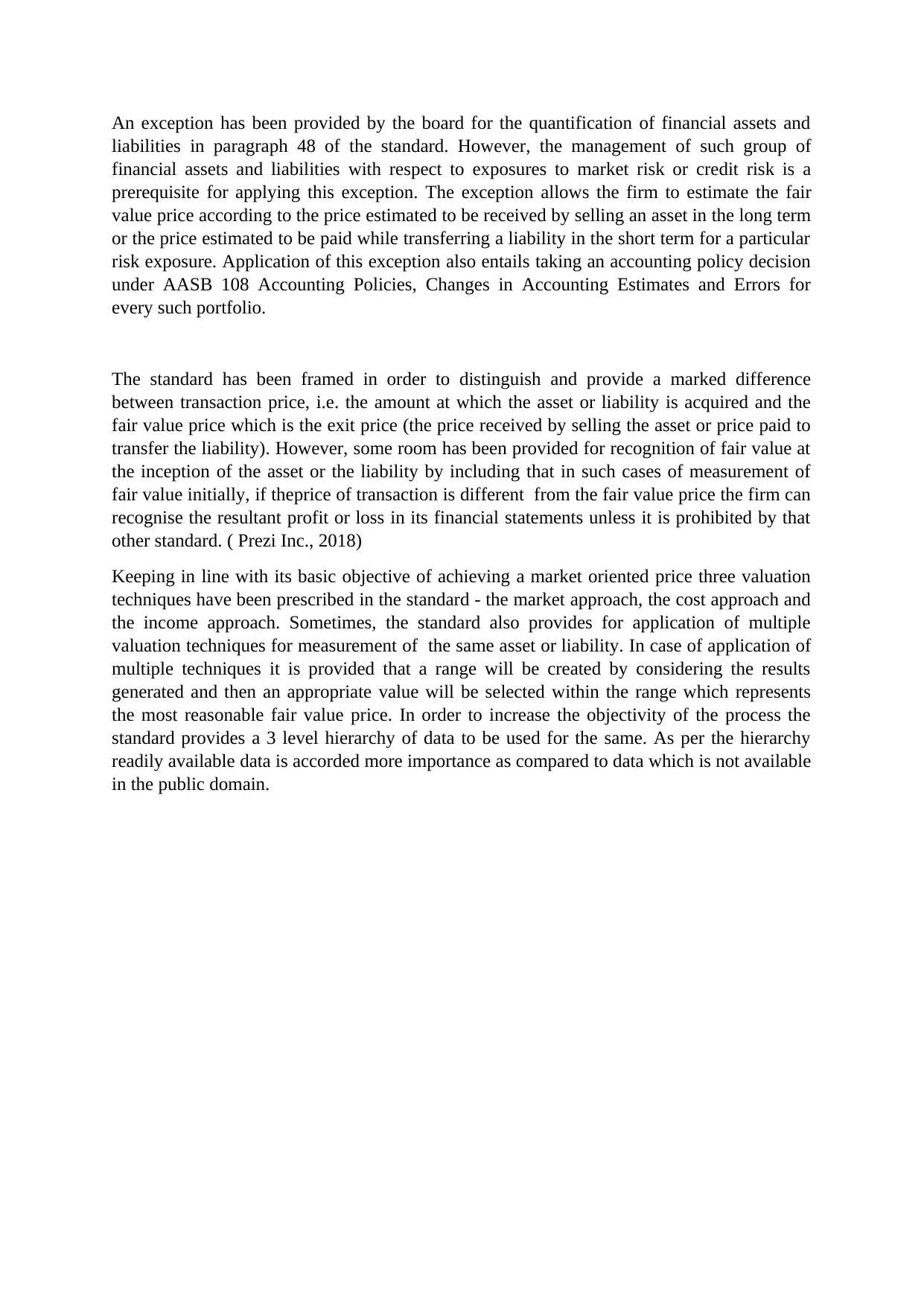
An exception has been provided by the board for the quantification of financial assets and
liabilities in paragraph 48 of the standard. However, the management of such group of
financial assets and liabilities with respect to exposures to market risk or credit risk is a
prerequisite for applying this exception. The exception allows the firm to estimate the fair
value price according to the price estimated to be received by selling an asset in the long term
or the price estimated to be paid while transferring a liability in the short term for a particular
risk exposure. Application of this exception also entails taking an accounting policy decision
under AASB 108 Accounting Policies, Changes in Accounting Estimates and Errors for
every such portfolio.
The standard has been framed in order to distinguish and provide a marked difference
between transaction price, i.e. the amount at which the asset or liability is acquired and the
fair value price which is the exit price (the price received by selling the asset or price paid to
transfer the liability). However, some room has been provided for recognition of fair value at
the inception of the asset or the liability by including that in such cases of measurement of
fair value initially, if theprice of transaction is different from the fair value price the firm can
recognise the resultant profit or loss in its financial statements unless it is prohibited by that
other standard. ( Prezi Inc., 2018)
Keeping in line with its basic objective of achieving a market oriented price three valuation
techniques have been prescribed in the standard - the market approach, the cost approach and
the income approach. Sometimes, the standard also provides for application of multiple
valuation techniques for measurement of the same asset or liability. In case of application of
multiple techniques it is provided that a range will be created by considering the results
generated and then an appropriate value will be selected within the range which represents
the most reasonable fair value price. In order to increase the objectivity of the process the
standard provides a 3 level hierarchy of data to be used for the same. As per the hierarchy
readily available data is accorded more importance as compared to data which is not available
in the public domain.
liabilities in paragraph 48 of the standard. However, the management of such group of
financial assets and liabilities with respect to exposures to market risk or credit risk is a
prerequisite for applying this exception. The exception allows the firm to estimate the fair
value price according to the price estimated to be received by selling an asset in the long term
or the price estimated to be paid while transferring a liability in the short term for a particular
risk exposure. Application of this exception also entails taking an accounting policy decision
under AASB 108 Accounting Policies, Changes in Accounting Estimates and Errors for
every such portfolio.
The standard has been framed in order to distinguish and provide a marked difference
between transaction price, i.e. the amount at which the asset or liability is acquired and the
fair value price which is the exit price (the price received by selling the asset or price paid to
transfer the liability). However, some room has been provided for recognition of fair value at
the inception of the asset or the liability by including that in such cases of measurement of
fair value initially, if theprice of transaction is different from the fair value price the firm can
recognise the resultant profit or loss in its financial statements unless it is prohibited by that
other standard. ( Prezi Inc., 2018)
Keeping in line with its basic objective of achieving a market oriented price three valuation
techniques have been prescribed in the standard - the market approach, the cost approach and
the income approach. Sometimes, the standard also provides for application of multiple
valuation techniques for measurement of the same asset or liability. In case of application of
multiple techniques it is provided that a range will be created by considering the results
generated and then an appropriate value will be selected within the range which represents
the most reasonable fair value price. In order to increase the objectivity of the process the
standard provides a 3 level hierarchy of data to be used for the same. As per the hierarchy
readily available data is accorded more importance as compared to data which is not available
in the public domain.
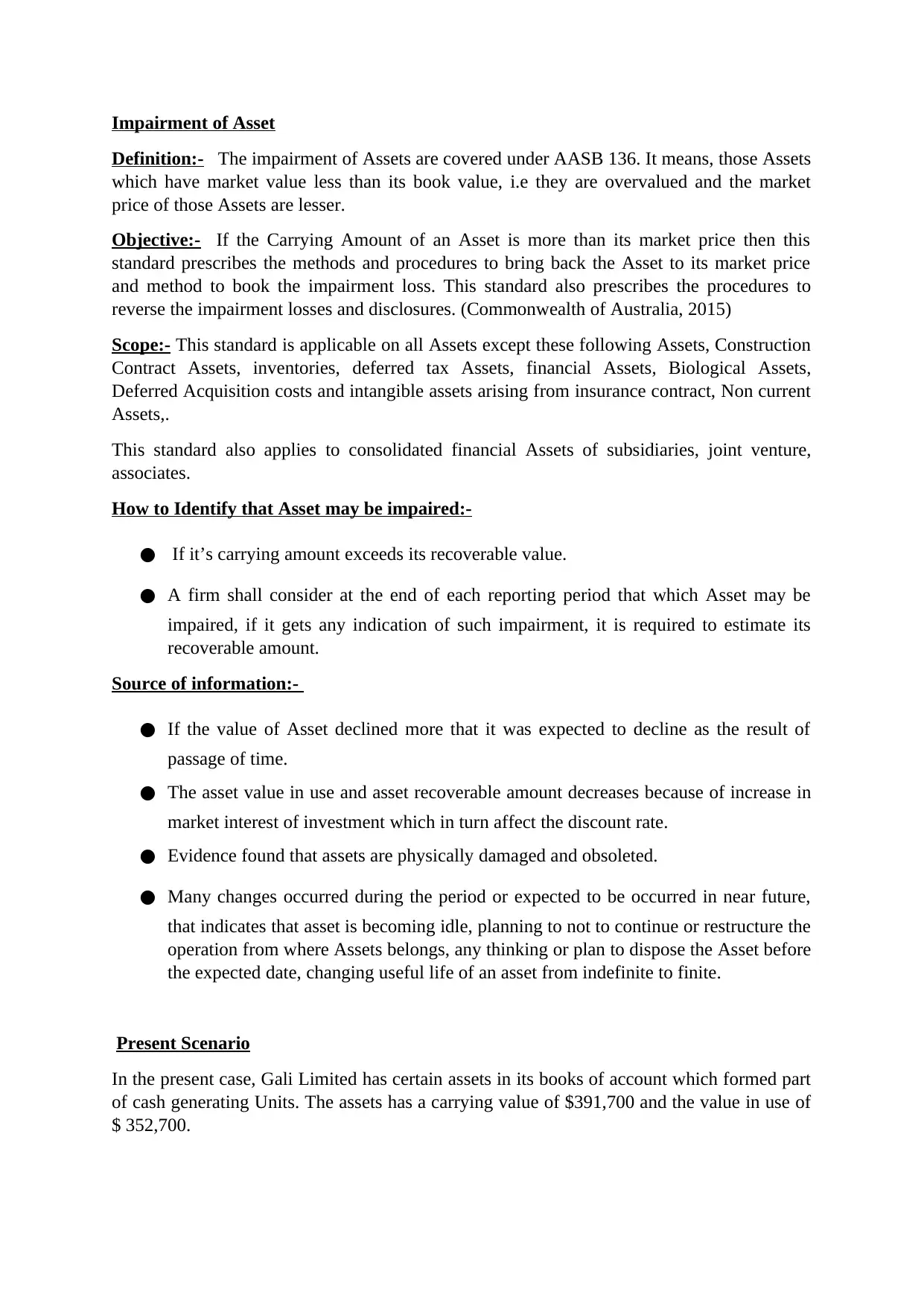
Impairment of Asset
Definition:- The impairment of Assets are covered under AASB 136. It means, those Assets
which have market value less than its book value, i.e they are overvalued and the market
price of those Assets are lesser.
Objective:- If the Carrying Amount of an Asset is more than its market price then this
standard prescribes the methods and procedures to bring back the Asset to its market price
and method to book the impairment loss. This standard also prescribes the procedures to
reverse the impairment losses and disclosures. (Commonwealth of Australia, 2015)
Scope:- This standard is applicable on all Assets except these following Assets, Construction
Contract Assets, inventories, deferred tax Assets, financial Assets, Biological Assets,
Deferred Acquisition costs and intangible assets arising from insurance contract, Non current
Assets,.
This standard also applies to consolidated financial Assets of subsidiaries, joint venture,
associates.
How to Identify that Asset may be impaired:-
● If it’s carrying amount exceeds its recoverable value.
● A firm shall consider at the end of each reporting period that which Asset may be
impaired, if it gets any indication of such impairment, it is required to estimate its
recoverable amount.
Source of information:-
● If the value of Asset declined more that it was expected to decline as the result of
passage of time.
● The asset value in use and asset recoverable amount decreases because of increase in
market interest of investment which in turn affect the discount rate.
● Evidence found that assets are physically damaged and obsoleted.
● Many changes occurred during the period or expected to be occurred in near future,
that indicates that asset is becoming idle, planning to not to continue or restructure the
operation from where Assets belongs, any thinking or plan to dispose the Asset before
the expected date, changing useful life of an asset from indefinite to finite.
Present Scenario
In the present case, Gali Limited has certain assets in its books of account which formed part
of cash generating Units. The assets has a carrying value of $391,700 and the value in use of
$ 352,700.
Definition:- The impairment of Assets are covered under AASB 136. It means, those Assets
which have market value less than its book value, i.e they are overvalued and the market
price of those Assets are lesser.
Objective:- If the Carrying Amount of an Asset is more than its market price then this
standard prescribes the methods and procedures to bring back the Asset to its market price
and method to book the impairment loss. This standard also prescribes the procedures to
reverse the impairment losses and disclosures. (Commonwealth of Australia, 2015)
Scope:- This standard is applicable on all Assets except these following Assets, Construction
Contract Assets, inventories, deferred tax Assets, financial Assets, Biological Assets,
Deferred Acquisition costs and intangible assets arising from insurance contract, Non current
Assets,.
This standard also applies to consolidated financial Assets of subsidiaries, joint venture,
associates.
How to Identify that Asset may be impaired:-
● If it’s carrying amount exceeds its recoverable value.
● A firm shall consider at the end of each reporting period that which Asset may be
impaired, if it gets any indication of such impairment, it is required to estimate its
recoverable amount.
Source of information:-
● If the value of Asset declined more that it was expected to decline as the result of
passage of time.
● The asset value in use and asset recoverable amount decreases because of increase in
market interest of investment which in turn affect the discount rate.
● Evidence found that assets are physically damaged and obsoleted.
● Many changes occurred during the period or expected to be occurred in near future,
that indicates that asset is becoming idle, planning to not to continue or restructure the
operation from where Assets belongs, any thinking or plan to dispose the Asset before
the expected date, changing useful life of an asset from indefinite to finite.
Present Scenario
In the present case, Gali Limited has certain assets in its books of account which formed part
of cash generating Units. The assets has a carrying value of $391,700 and the value in use of
$ 352,700.
⊘ This is a preview!⊘
Do you want full access?
Subscribe today to unlock all pages.

Trusted by 1+ million students worldwide
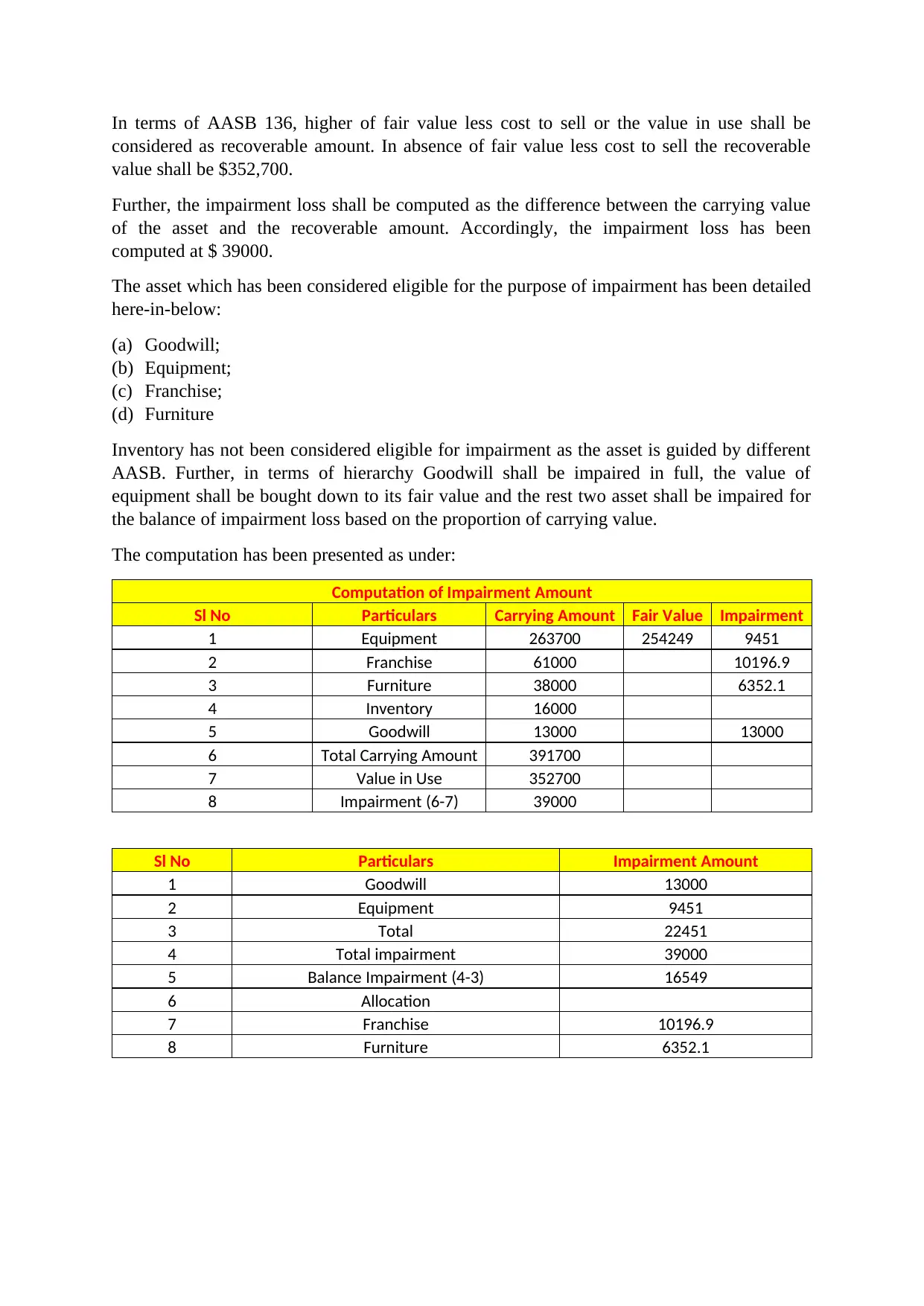
In terms of AASB 136, higher of fair value less cost to sell or the value in use shall be
considered as recoverable amount. In absence of fair value less cost to sell the recoverable
value shall be $352,700.
Further, the impairment loss shall be computed as the difference between the carrying value
of the asset and the recoverable amount. Accordingly, the impairment loss has been
computed at $ 39000.
The asset which has been considered eligible for the purpose of impairment has been detailed
here-in-below:
(a) Goodwill;
(b) Equipment;
(c) Franchise;
(d) Furniture
Inventory has not been considered eligible for impairment as the asset is guided by different
AASB. Further, in terms of hierarchy Goodwill shall be impaired in full, the value of
equipment shall be bought down to its fair value and the rest two asset shall be impaired for
the balance of impairment loss based on the proportion of carrying value.
The computation has been presented as under:
Computation of Impairment Amount
Sl No Particulars Carrying Amount Fair Value Impairment
1 Equipment 263700 254249 9451
2 Franchise 61000 10196.9
3 Furniture 38000 6352.1
4 Inventory 16000
5 Goodwill 13000 13000
6 Total Carrying Amount 391700
7 Value in Use 352700
8 Impairment (6-7) 39000
Sl No Particulars Impairment Amount
1 Goodwill 13000
2 Equipment 9451
3 Total 22451
4 Total impairment 39000
5 Balance Impairment (4-3) 16549
6 Allocation
7 Franchise 10196.9
8 Furniture 6352.1
considered as recoverable amount. In absence of fair value less cost to sell the recoverable
value shall be $352,700.
Further, the impairment loss shall be computed as the difference between the carrying value
of the asset and the recoverable amount. Accordingly, the impairment loss has been
computed at $ 39000.
The asset which has been considered eligible for the purpose of impairment has been detailed
here-in-below:
(a) Goodwill;
(b) Equipment;
(c) Franchise;
(d) Furniture
Inventory has not been considered eligible for impairment as the asset is guided by different
AASB. Further, in terms of hierarchy Goodwill shall be impaired in full, the value of
equipment shall be bought down to its fair value and the rest two asset shall be impaired for
the balance of impairment loss based on the proportion of carrying value.
The computation has been presented as under:
Computation of Impairment Amount
Sl No Particulars Carrying Amount Fair Value Impairment
1 Equipment 263700 254249 9451
2 Franchise 61000 10196.9
3 Furniture 38000 6352.1
4 Inventory 16000
5 Goodwill 13000 13000
6 Total Carrying Amount 391700
7 Value in Use 352700
8 Impairment (6-7) 39000
Sl No Particulars Impairment Amount
1 Goodwill 13000
2 Equipment 9451
3 Total 22451
4 Total impairment 39000
5 Balance Impairment (4-3) 16549
6 Allocation
7 Franchise 10196.9
8 Furniture 6352.1
Paraphrase This Document
Need a fresh take? Get an instant paraphrase of this document with our AI Paraphraser
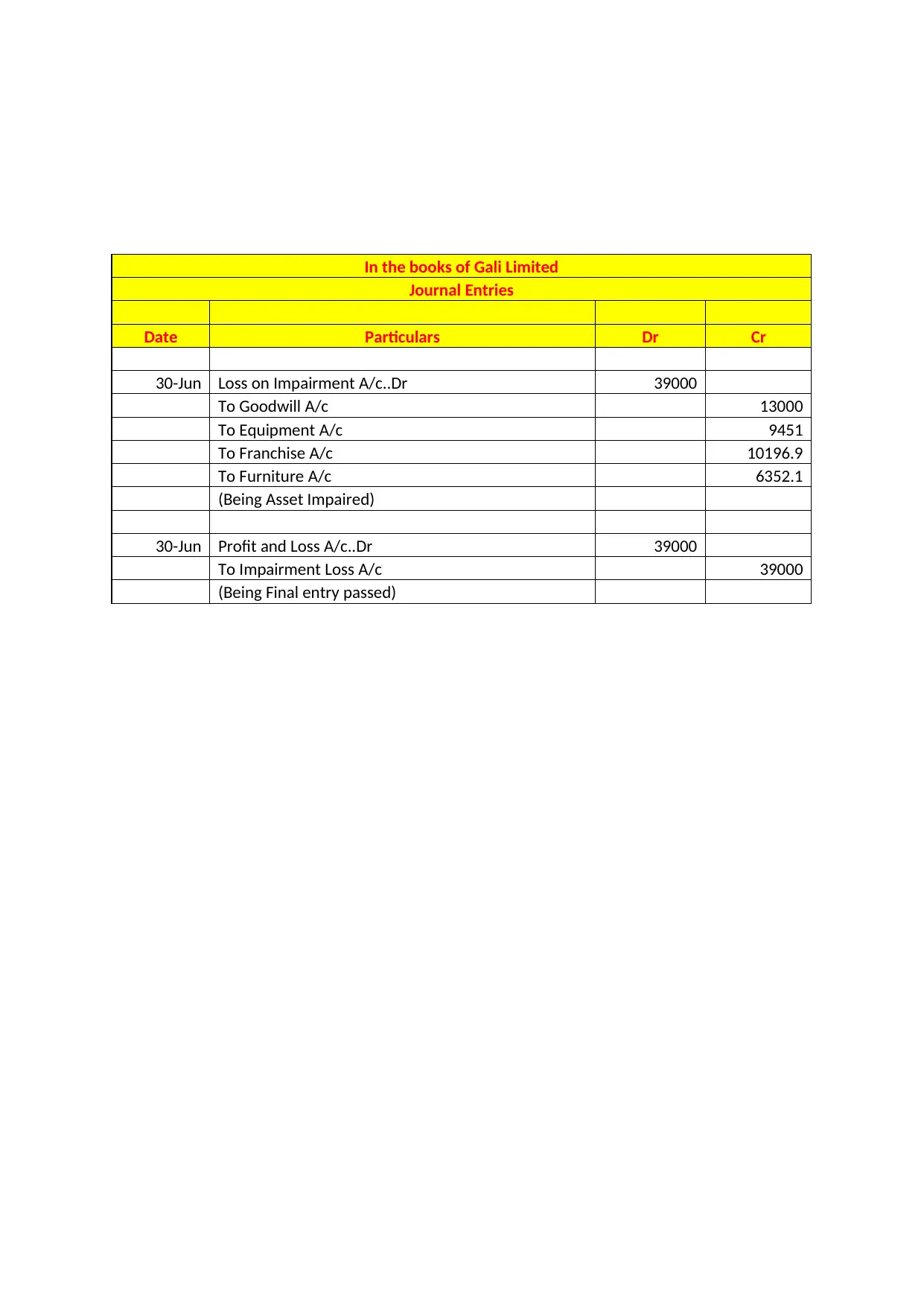
In the books of Gali Limited
Journal Entries
Date Particulars Dr Cr
30-Jun Loss on Impairment A/c..Dr 39000
To Goodwill A/c 13000
To Equipment A/c 9451
To Franchise A/c 10196.9
To Furniture A/c 6352.1
(Being Asset Impaired)
30-Jun Profit and Loss A/c..Dr 39000
To Impairment Loss A/c 39000
(Being Final entry passed)
Journal Entries
Date Particulars Dr Cr
30-Jun Loss on Impairment A/c..Dr 39000
To Goodwill A/c 13000
To Equipment A/c 9451
To Franchise A/c 10196.9
To Furniture A/c 6352.1
(Being Asset Impaired)
30-Jun Profit and Loss A/c..Dr 39000
To Impairment Loss A/c 39000
(Being Final entry passed)
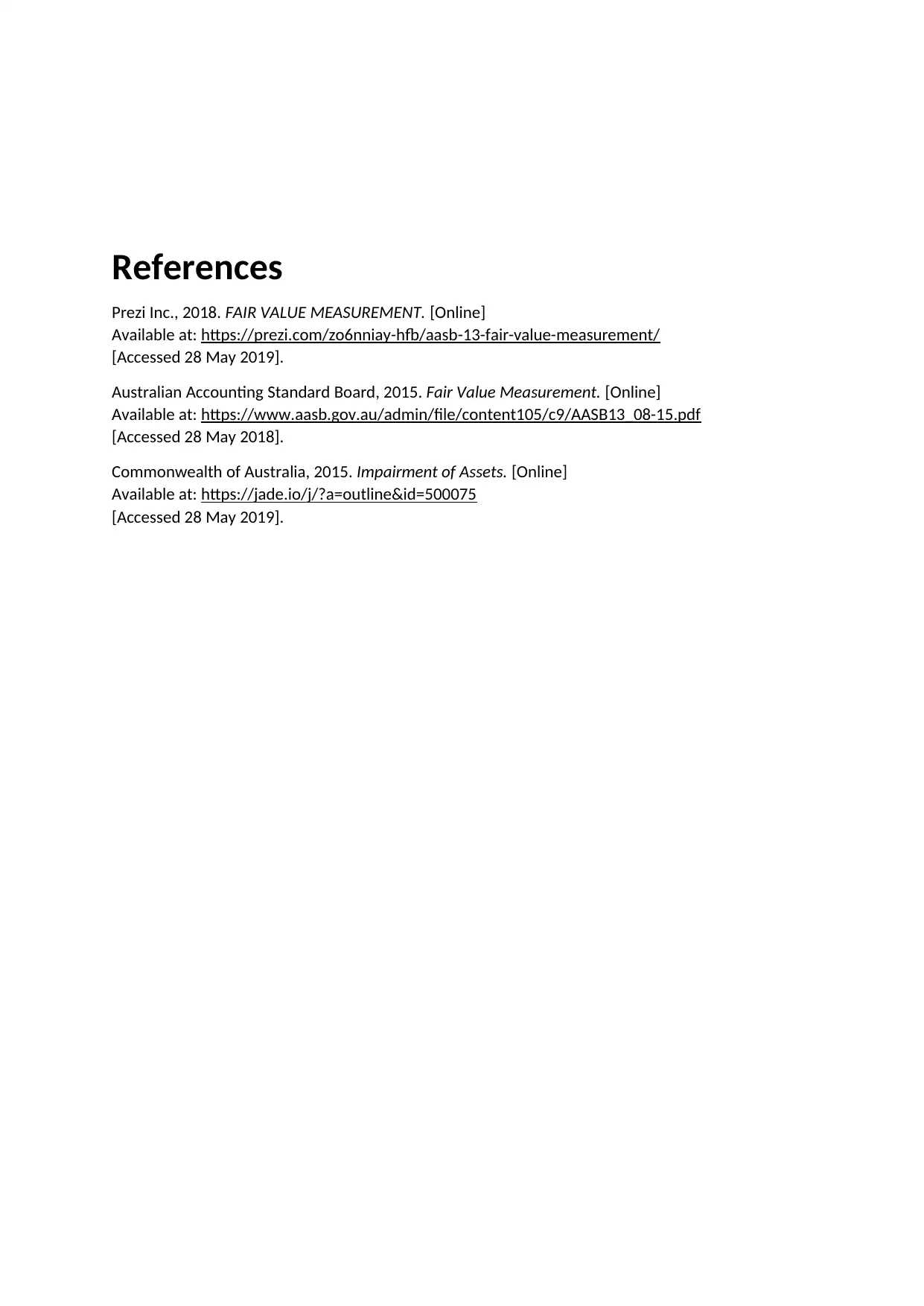
References
Prezi Inc., 2018. FAIR VALUE MEASUREMENT. [Online]
Available at: https://prezi.com/zo6nniay-hfb/aasb-13-fair-value-measurement/
[Accessed 28 May 2019].
Australian Accounting Standard Board, 2015. Fair Value Measurement. [Online]
Available at: https://www.aasb.gov.au/admin/file/content105/c9/AASB13_08-15.pdf
[Accessed 28 May 2018].
Commonwealth of Australia, 2015. Impairment of Assets. [Online]
Available at: https://jade.io/j/?a=outline&id=500075
[Accessed 28 May 2019].
Prezi Inc., 2018. FAIR VALUE MEASUREMENT. [Online]
Available at: https://prezi.com/zo6nniay-hfb/aasb-13-fair-value-measurement/
[Accessed 28 May 2019].
Australian Accounting Standard Board, 2015. Fair Value Measurement. [Online]
Available at: https://www.aasb.gov.au/admin/file/content105/c9/AASB13_08-15.pdf
[Accessed 28 May 2018].
Commonwealth of Australia, 2015. Impairment of Assets. [Online]
Available at: https://jade.io/j/?a=outline&id=500075
[Accessed 28 May 2019].
⊘ This is a preview!⊘
Do you want full access?
Subscribe today to unlock all pages.

Trusted by 1+ million students worldwide
1 out of 6
Related Documents
Your All-in-One AI-Powered Toolkit for Academic Success.
+13062052269
info@desklib.com
Available 24*7 on WhatsApp / Email
![[object Object]](/_next/static/media/star-bottom.7253800d.svg)
Unlock your academic potential
Copyright © 2020–2025 A2Z Services. All Rights Reserved. Developed and managed by ZUCOL.





